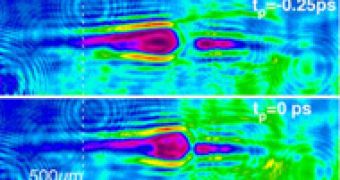What happens when you throw a golf ball at a locomotive speeding toward you? The ball will bounce off it and come flying back at you with tremendous energy, just before you get run over. This is what scientists are trying to study with a new generation of x-ray lasers.
Scientists developed a new method of producing intense pulses of x-rays by whacking ordinary laser light with a wave of plasma. It's also similar to tennis, where the ball receives a highly energetic impulse from the player, reaching impressive speeds.
It seems the new technique is just as effective as the huge x-ray machines currently used in research labs around the world, but the cost is at a fraction of the original. Presently, x-rays are used to probe all sorts of materials including living flesh, crystallized proteins and high-temperature superconductors.
Now, researchers work on developing a completely new kind of precision instrument, an x-ray laser. In an ordinary laser beam, the photons travel in quantum-mechanical lockstep, so laser light interacts with matter in ways that ordinary "incoherent" light cannot.
Thus, if many molecules are frozen into a crystal, ordinary x-rays can determine the structure of those molecules, for instance proteins. The new advances could mean that only a single molecule would be enough to perform a complete analysis. This is what scientists hope to achieve with an ultraintense x-ray laser.
As for all emerging technologies, the giants in the field are rushing to get their hands on a piece of the x-ray laser pie. The Stanford Linear Accelerator Center in Menlo Park, California, the German accelerator lab DESY in Hamburg and the Japan Synchrotron Radiation Research Institute in Harima Science Garden City, these are just some of the most important competitors.
They are all trying to create an X-FEL (X-ray Free Electron Laser), an x-ray laser that shares the same optical properties as conventional lasers such as emitting a beam consisting of coherent electromagnetic radiation which can reach high power, but which uses some very different operating principles to form the beam.
These lasers will generate x-ray laser light by firing particle beams through special arrangements of magnets. For now, such applications cost hundreds of millions of dollars, but one team of scientists says they've already got the answer.
However, Sergei Bulanov of the Advanced Photon Research Center at the Japan Atomic Energy Agency in Kyoto and colleagues say they have a prototype that can generate pulses of x-ray laser light on the cheap. This will open the way for faster and more productive research on the matter.

 14 DAY TRIAL //
14 DAY TRIAL //